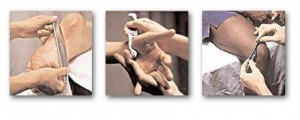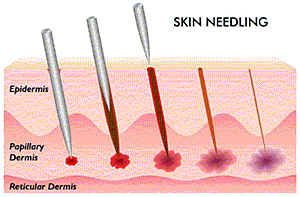 The Graston Technique is an instrument-assisted, soft tissue mobilization therapy. The Graston Technique safely removes scar tissues and scar tissue adhesions that have occurred as a result of chronic inflammation, injuries, repetitive motion or from old injuries of the past.
The Graston Technique is an instrument-assisted, soft tissue mobilization therapy. The Graston Technique safely removes scar tissues and scar tissue adhesions that have occurred as a result of chronic inflammation, injuries, repetitive motion or from old injuries of the past.
Graston Technique enables practitioners to effectively detect and treat scar tissue and restrictions that affect normal function. The technique uses specially-designed stainless steel instruments, along with appropriate therapeutic exercise, to specifically detect and effectively treat areas exhibiting soft tissue fibrosis or chronic inflammation.
Graston instruments are used to enhance the practitioner’s ability to detect adhesion, and scar tissue in the affected area. The stainless steel instruments are moved over the area of concern and “catch” on fibrotic tissue, which immediately identifies the areas of restriction. Once the tissue has been identified, the instruments are used to break up the scar tissue so it can be absorbed by the body. Each instruments combines concave and convex shapes to allow the instruments to mold to various contours of the body. This allows the practitioner to isolate adhesions and restrictions, and treat them very precisely.
The instruments are beneficial in breaking up fascial restrictions, scar tissue adhesions, and detecting areas of chronic inflammation and fibrosis.
Graston treatments can help with conditions such as :
Cervical sprain/strain
Carpal Tunnel Syndrome
Tennis & Golfers elbow
Rotator Cuff Tendinosis
Achilles Tendinosis
Scar Tissue
Lumbar sprain/strain
Plantar Fasciitis
Knee Pain/ Runners Knee
Fibromyalgia
The goal of this therapy is to reduce the patient’s pain and increase function by breaking down the scar tissue and fascia restrictions that are usually associated with some form of trauma to the soft tissue (e.g., a strained muscle or a pulled ligament, tendon, or fascia). This therapy also reduces restrictions by stretching connective tissue by rearranging the structure of the soft tissue being treated (e.g., muscle, fascia, tendons, ligaments).
Normal tissue can be dense, with regular elongated fibers running in the same direction, such as tendons and ligaments; or dense, irregular and loose with fibers running in multiple directions. In either instance, when tissue is damaged it will heal in a haphazard pattern–or scarring–that results in a restricted range of motion and in many instances causes pain, which prevents the patient from functioning as they did before the injury.
The Graston Technique separates and breaks down collagen cross-links, and splays and stretches connective tissue and muscle fibers, increases skin temperature, increases the rate and amount of blood flow to and from the area, increases cellular activity in the region, and facilitates reflex changes in the chronic muscle holding patterns.
The Graston Technique can be used in conjunction with both Ultrasound, and Laser Therapy to help speed up the recovery time.


